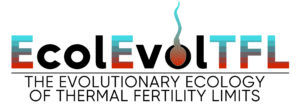Reproduction in a warming world – investigating climate change and fertility in important insects
We are starting to see the devastating impacts of climate change, including accelerating biodiversity loss. However, most biological predictions of how climate change will impact species’ ranges and population persistence are based on the lethal temperatures. We’ve recently learnt that many species can become entirely sterile at temperatures well below those that kill them, meaning the effects of climate change have been underestimated. We urgently need to understand what makes species vulnerable to fertility loss at high temperatures (Walsh et al 2019 Trends in Ecology and Evolution).
Temperature has profound effects on biochemical processes governing the behaviour, physiology and therefore distribution of many species. Recent work from ourselves and others in over 40 fruit fly species, males become entirely sterile at temperatures lower than those that kill them (Parratt et al 2021 Nature Climate Change; Van Heerwaarden and Sgro 2021 Nat Comms). These Thermal Fertility Limits are a better match to species ranges than lethal temperatures alone and predict population extinction risk, showing that even though fertility was measured in a lab setting it is important for species in nature. However, there are many open questions that urgently need addressing. For example, how do the impacts of heatwaves on individual reproduction translate to population level processes; whether we can measure signatures of heat waves in natural populations; how temperature interacts with other climate stressors, such as humidity or resource availability (Mugabo et al. 2019 Journal of Animal Ecology); what capacity there is to evolve to cope with heatwaves.
To tackle these questions, we will use a range of insect species to conduct reproductive assessments in the lab, in animals from the wild, or in semi-natural mesocosms. You would also take part in an international network measuring the effect of natural heatwaves on fertility in woodlice. Part of this could be to assess genomic patterns that could underlie adaptation to local climate.
You would be working with the Bretman and Sait groups in Leeds who are studying temperature effects on life histories. Currently our labs have projects funded by the NERC and BBSRC on understanding the molecular mechanisms that make sperm vulnerable to high temperature, and how climate change will affect multi-trophic systems using a host-parasitoid model. You would also be part of an international network of researchers studying this topic across species and populations using a wide range of techniques, funded by the European Society for Evolutionary Biology, co-led by Bretman.
Read more:
https://doi.org/10.1038/s41558-021-01047-0
https://doi.org/10.1093/jeb/voae021
https://doi.org/10.1002/2688-8319.12303


